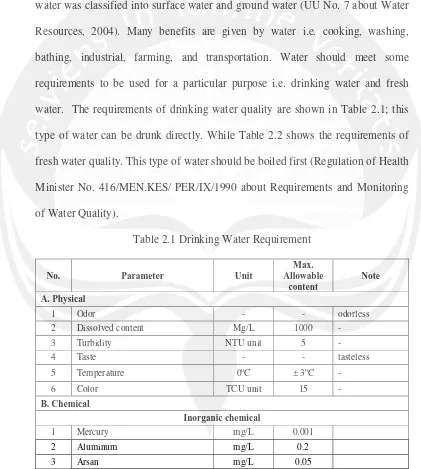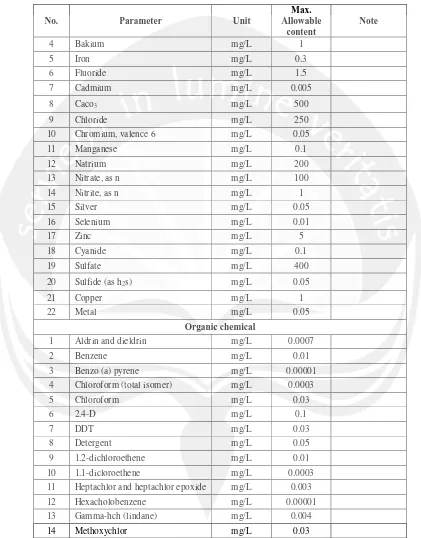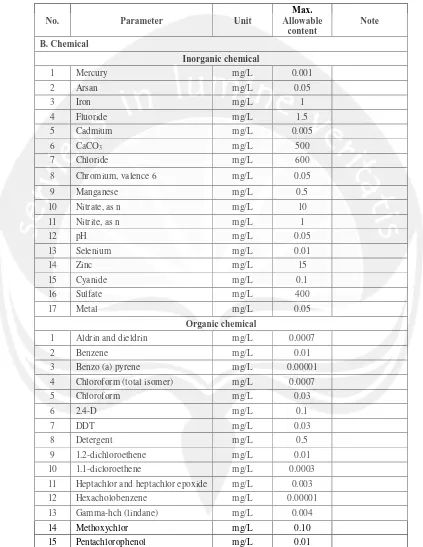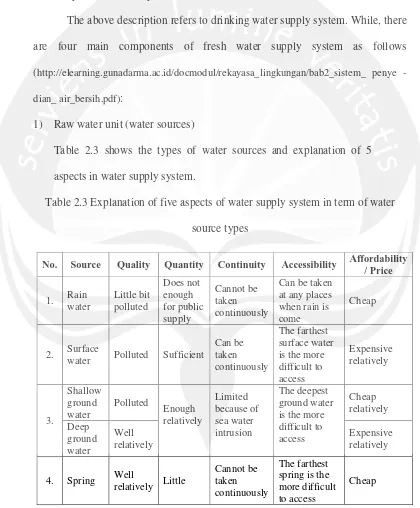5 CHAPTER II LITERATURE REVIEW
Water is renewable resources (Kodoatie, 2002). Based on its location
water was classified into surface water and ground water (UU No. 7 about Water
Resources, 2004). Many benefits are given by water i.e. cooking, washing,
bathing, industrial, farming, and transportation. Water should meet some
requirements to be used for a particular purpose i.e. drinking water and fresh
water. The requirements of drinking water quality are shown in Table 2.1; this
type of water can be drunk directly. While Table 2.2 shows the requirements of
fresh water quality. This type of water should be boiled first (Regulation of Health
Minister No. 416/MEN.KES/ PER/IX/1990 about Requirements and Monitoring
of Water Quality).
Table 2.1 Drinking Water Requirement
No. Parameter Unit
Max. Allowable
content
Note
A. Physical
1 Odor - - odorless
2 Dissolved content Mg/L 1000 -
3 Turbidity NTU unit 5 -
4 Taste - - tasteless
5 Temperature 0oC ± 3oC -
6 Color TCU unit 15 -
B. Chemical
Inorganic chemical
1 Mercury mg/L 0.001
2 Aluminum mg/L 0.2
3 Arsan mg/L 0.05
6 Table 2.1 Drinking Water Requirement (Cont’)
No. Parameter Unit
Max. Allowable
content
Note
4 Bakium mg/L 1
5 Iron mg/L 0.3
6 Fluoride mg/L 1.5
7 Cadmium mg/L 0.005
8 Caco3 mg/L 500
9 Chloride mg/L 250
10 Chromium, valence 6 mg/L 0.05
11 Manganese mg/L 0.1
12 Natrium mg/L 200
13 Nitrate, as n mg/L 100
14 Nitrite, as n mg/L 1
15 Silver mg/L 0.05
16 Selenium mg/L 0.01
17 Zinc mg/L 5
18 Cyanide mg/L 0.1
19 Sulfate mg/L 400
20 Sulfide (as h2s) mg/L 0.05
21 Copper mg/L 1
22 Metal mg/L 0.05
Organic chemical
1 Aldrin and dieldrin mg/L 0.0007
2 Benzene mg/L 0.01
3 Benzo (a) pyrene mg/L 0.00001
4 Chloroform (total isomer) mg/L 0.0003
5 Chloroform mg/L 0.03
6 2.4-D mg/L 0.1
7 DDT mg/L 0.03
8 Detergent mg/L 0.05
9 1.2-dichloroethene mg/L 0.01
10 1.1-dicloroethene mg/L 0.0003
11 Heptachlor and heptachlor epoxide mg/L 0.003
12 Hexacholobenzene mg/L 0.00001
13 Gamma-hch (lindane) mg/L 0.004
14 Methoxychlor mg/L 0.03
7 Table 2.1 Drinking Water Requirement (Cont’)
No. Parameter Unit
Max. Allowable
content
Note
15 Pentachlorophenol mg/L 0.01
16 Pesticide total mg/L 0.1
17 2.4.6-trichloropenol mg/L 0.01
18 KmnO4 mg/L 10
Microbiology
1 Koliform feces per 100 ml 0
2 Total coliform per 100 ml 0
95% of checked sample.
Sometimes can be 3 per 100 ml water sample, but not in a row Radio active
1 Gross alpha activity Bg/L 0.1
2 Gross beta activity Bg/L 1
(Source: Regulation of Health Minister No. 416/MEN.KES/ PER/IX/1990 about Requirements and Monitoring of Water Quality)
Table 2.2 Fresh Water Requirement
No. Parameter Unit
Max. Allowable
content
Note
A. Physical
1 Odor - - odorless
2 Dissolved content Mg/L 1000 -
3 Turbidity NTU unit 5 -
4 Taste - - tasteless
5 Temperature 0oC ±3oC -
6 Color TCU unit 15 -
(Source: Regulation of Health Minister No. 416/MEN.KES/ PER/IX/1990 about Requirements and Monitoring of Water Quality)
Note:
mg = milligram ml = milliliter L = Liter Bg = Beguerel
NTU = Nepnelometrik Turbidity Units TCU = True Color Units
8 Table 2.2 Fresh Water Requirement (Cont’)
No. Parameter Unit
Max. Allowable
content
Note
B. Chemical
Inorganic chemical
1 Mercury mg/L 0.001
2 Arsan mg/L 0.05
3 Iron mg/L 1
4 Fluoride mg/L 1.5
5 Cadmium mg/L 0.005
6 CaCO3 mg/L 500
7 Chloride mg/L 600
8 Chromium, valence 6 mg/L 0.05
9 Manganese mg/L 0.5
10 Nitrate, as n mg/L 10
11 Nitrite, as n mg/L 1
12 pH mg/L 0.05
13 Selenium mg/L 0.01
14 Zinc mg/L 15
15 Cyanide mg/L 0.1
16 Sulfate mg/L 400
17 Metal mg/L 0.05
Organic chemical
1 Aldrin and dieldrin mg/L 0.0007
2 Benzene mg/L 0.01
3 Benzo (a) pyrene mg/L 0.00001
4 Chloroform (total isomer) mg/L 0.0007
5 Chloroform mg/L 0.03
6 2.4-D mg/L 0.1
7 DDT mg/L 0.03
8 Detergent mg/L 0.5
9 1.2-dichloroethene mg/L 0.01
10 1.1-dicloroethene mg/L 0.0003
11 Heptachlor and heptachlor epoxide mg/L 0.003
12 Hexacholobenzene mg/L 0.00001
13 Gamma-hch (lindane) mg/L 0.004
14 Methoxychlor mg/L 0.10
15 Pentachlorophenol mg/L 0.01
9 Table 2.2 Fresh Water Requirement (Cont’)
No. Parameter Unit
Max. Allowable
content
Note
16 Pesticide total mg/L 0.1
17 2.4.6-trichloropenol mg/L 0.01
18 KmnO4 mg/L 10
Microbiology
1 Coliform feces per 100 ml 0 Not pipe water
2 Total coliform per 100 ml 0 Not pipe water
Radio active
1 Gross alpha activity Bg/L 0.1
2 Gross beta activity Bg/L 1
(Source: Regulation of Health Minister No. 416/MEN.KES/ PER/IX/1990 about Requirements and Monitoring of Water Quality)
Note:
mg = milligram ml = milliliter L = Liter Bg = Beguerel
NTU = Nepnelometrik Turbidity Units TCU = True Color Units
Heavy metal is dissolved metal
Not all types of water can be classified either as drinking water or fresh
water. In other word, one or more ways are needed to treat such particular water
so that it will meet the requirement of drinking water or fresh water. This effort is
conducted to serve water to customers.
In the effort of supplying water, there are several components that
integrated in a system, called water supply system. A water supply system should
consist of source, transmission, treatment, storage, distribution, and service area.
The concept about water supply system was described by some experts.
Linsley (1992) describes that water – supply system included (1) source(s) of
supply, (2) storage facilities, (3) transmission (to treatment) facilities, (4)
10 facilities, and (6) distribution facilities. Other description comes from Kodoatie
(2003) where a water – supply system included (1) exploration of water resources,
(2) treatment (purification, water bacteria control, water chemical composition),
(3) storage, and (4)transmission (pipeline, water tank truck, and other modes), (5)
distribution (pipe network system, patch system, fittings, control, valve, and
pump). Furthermore, Regulation of Public Work Minister No. 18/PRT/M/2007
about Implementation of Water Supply System Development determined 4 (four)
units for a water supply system as follows:
1) Water sources
Water sources is a withdrawal and / or raw water – supply
infrastructure, including intake structure water storage structure, ,
measuring and observation tool, pump system and or carrier infrastructure
structure and its equipment.
2) Production unit
Production unit is an infrastructure which can be used for treating
raw water to become drinking water through physical, chemical and
biological process, including treatment structure and its equipment’s,
operational equipment’s, measuring and observation tools, and storage
structure for drinking water.
3) Distribution unit
Distribution unit is an infrastructure for flowing drinking water
11 4) Service unit.
Service unit is an infrastructure that allowing the citizen to taking
drinking water from it directly, which consist of house connection, public
hydrant and fire hydrant.
The above description refers to drinking water supply system. While, there
are four main components of fresh water supply system as follows
(http://elearning.gunadarma.ac.id/docmodul/rekayasa_lingkungan/bab2_sistem_ penye
-dian_ air_bersih.pdf):
1) Raw water unit (water sources)
Table 2.3 shows the types of water sources and explanation of 5
aspects in water supply system.
Table 2.3 Explanation of five aspects of water supply system in term of water
source types
No. Source Quality Quantity Continuity Accessibility Affordability
/ Price
1. Rain water Little bit polluted Does not enough for public supply Cannot be taken continuously
Can be taken at any places when rain is come
Cheap
2. Surface
water Polluted Sufficient
Can be taken continuously
The farthest surface water is the more difficult to access Expensive relatively 3. Shallow ground water Polluted Enough relatively Limited because of sea water intrusion The deepest ground water is the more difficult to access Cheap relatively Deep ground water Well relatively Expensive relatively
4. Spring Well
relatively Little
Cannot be taken continuously
The farthest spring is the more difficult to access
12 2) Intake
This unit is divided into two sub unit are as follows:
a. Intake
Intake is a withdrawal structure for capturing the raw water.
Capacity of intake depends on the raw water discharge that will be treated.
There are five types of intake according to water withdrawal
location; those are river intake, canal intake, direct intake, reservoir intake
and spring intake.
b. Transmission
Transmission system is a pipe system from intake structure to the
treatment structure. The equipments which exist in transmission pipe
system are as follows:
• Wash out
This equipment is used for cleaning transmission pipe from sediment
inside that pipe.
• Air valve
This equipment is used for decreasing pressure inside the pipe so that
the pipe will not breakdown.
• Blow off
• Gate valve
This equipment is used for controlling water discharge.
13 3) Treatment
Water treatment process is depending on its water source quality. The
better the quality of water source the simpler water treatment process and the
poorer the quality of water source the more complex the water treatment.
There are two types of fresh water treatment as follows:
a. Surface water treatment
The structures needed in this kind of treatment are as follows:
• Intake
This equipment is use for tapping the water from water source.
• Structure for pre-sedimentation
This structure functions as a place for settling discreet particle like sand,
clay and other solid substance which can be settled gravitationally.
• Structure for rapid mixing
This structure functions as a place for mixing coagulant with raw water.
• Structure for slow mixing
This structure functions as a place for formalizing flock. This process
calls flocculation.
• Structure for sedimentation
This structure functions as a place for settling flock.
• Structure for filtration
This structure functions as a place for filtering the unsettled dirt and as
a filter for filtering microorganism.
14 This structure functions as a place for dissolving chemical substance to
treatment structure.
• Reservoir
This structure functions as a place for water temporary storage, before
the water was distributed.
b. Ground water treatment
• Aerobic ground water
The quality of aerobic water usually fulfills the requirement, but a little
bit acid. Then, treatment for increasing pH level to be neutral (7) is
needed.
• Anaerobic ground water
Usually anaerobic groundwater contains Fe, manganese ammonia and
H2S. The appropriate treatment for this kind of water is aeration. The
purpose of this treatment is for binding getting O2 into the water,
removing H2S and CH4, and reducing CO2 concentration.
4) Distribution
There are two types of distribution systems, those are:
a. Gravitational flow
This type is used whenever water pressure is enough to reach the most
15 b. Pumping flow
This type is used whenever water pressure is not enough to reach the most
remote point of service area. Needed equipments in fresh water
distribution are as follows:
• Reservoir
The function of reservoir is for collecting or storing fresh water which
has been treated before. The other function of this equipment is for
giving pressure to the water. Two types of reservoirs are as follows:
Ground reservoir
This structure is for storing water under the ground.
Elevated reservoir
This structure is for storing water on the ground with certain
elevation, so that water pressure is enough for reaching the most
remote point of service area.
• Pipe type
In water distribution system, there are two types of pipe material. Those
are PVC and galvanic pipes. Usually PVC pipe is used as branching
pipe. While galvanic pipe is used as distribution pipe which directly
reaches the customers
• Valve
Valve is used controlling water flow inside the pipe and stopping the
16
• Water meter
Water meter is used for measuring amount of water flow.
• Flow restrictor
This equipment is used for limiting amount of water either for
household or public hydrant, so that the distribution can be spread
equally.
• Pipe accessories
Pipe accessories that functioned as pipe connector in water distribution
system are as follows:
Socket
Flense
Water mull and nipple
Gibault connector
Dope and plug
Bend
Tee
Water supply system should not only serve a good quality of water, but
also should keep the stability of water quantity, should keep water continuity,
facilitate affordability of water price and service accessibility.
A number of complaints about PDAM performance are comes from almost
all customers even the head of its administrative area (Regent of Kupang District).
17 (http://sindikasi.inilah.com/read/detail/1792758/bupati-kupang-malu-dengan-
konsumen-pdam).
With the waterloss ratio of 49, 58%, PDAM Kabupaten Kupang is far from
the referred standard of 20 %. (Rumiyanto, 2009,
http://kupang.tribunnews.com/read/artikel/56716)
Customers in some villages are complaint about the service of PDAM
Kabupaten Kupang, because the water is no longer flows on schedule. In order to
fulfill the daily needs, customers should bought water from some private sellers.
The customers consider this is unfair for them. They have to pay regularly on
time, but PDAM does not provide consistent service in term of water distribution





